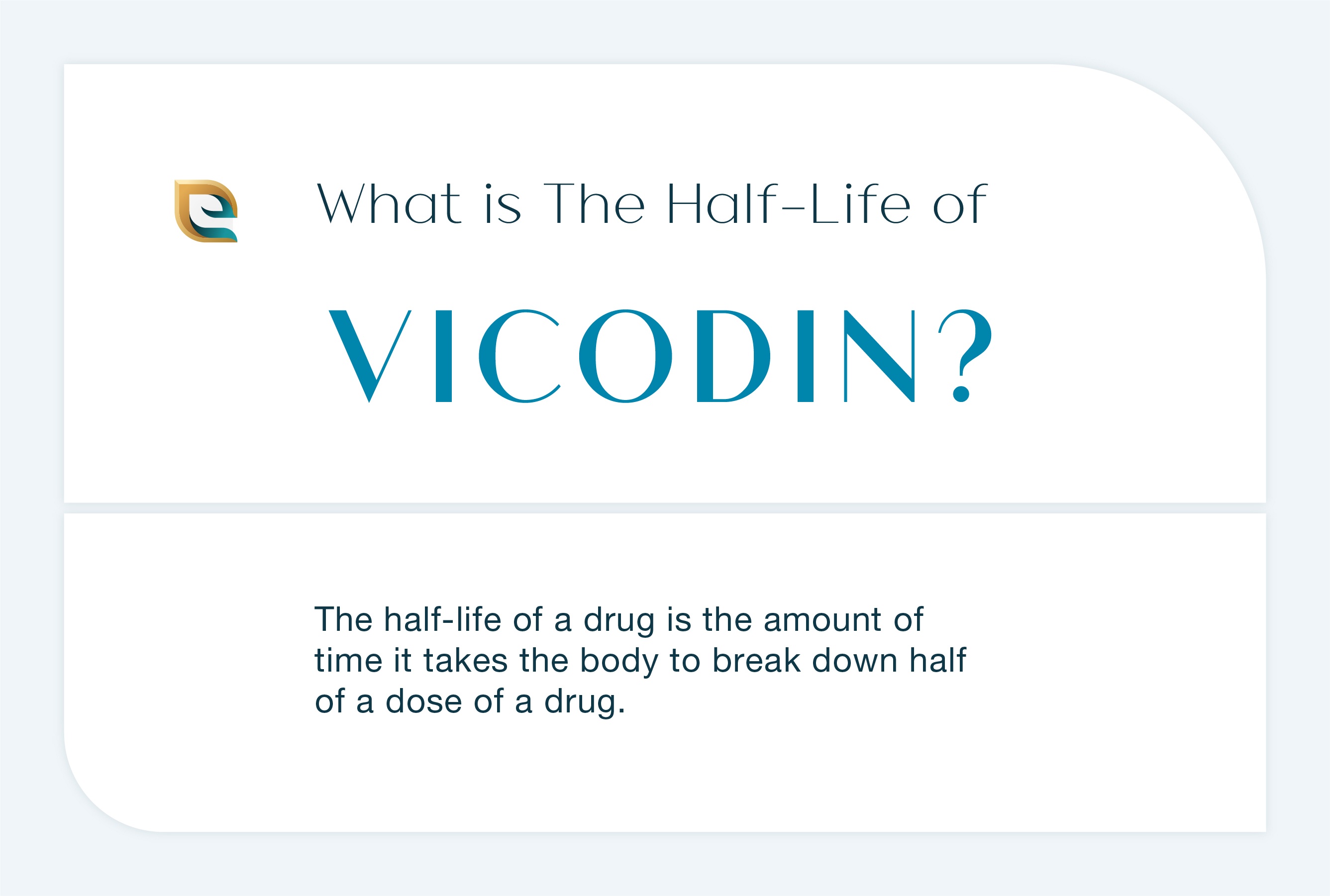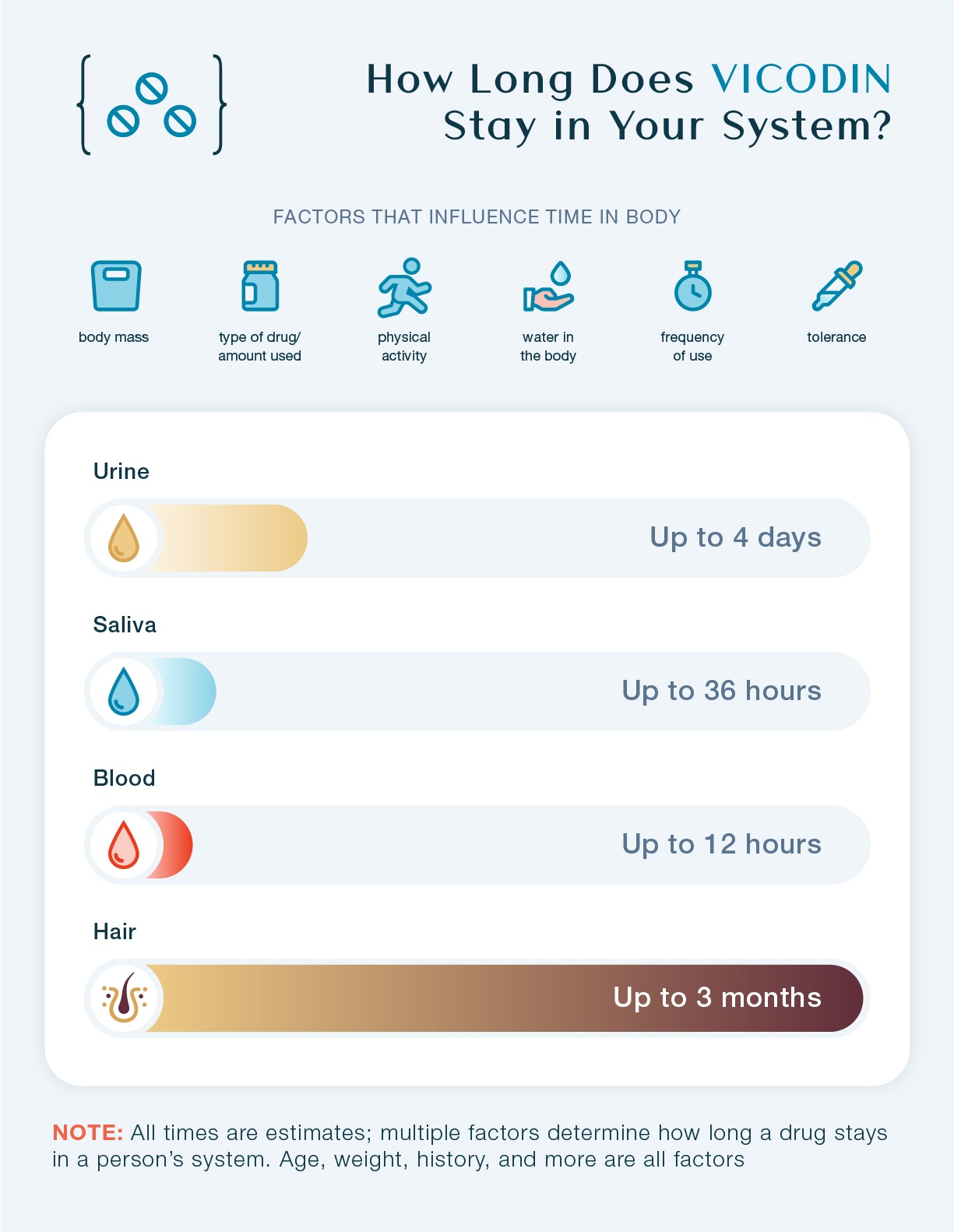Drug and Alcohol - Opioid Addiction
Vicodin Addiction: How Long Does Vicodin Stay in Your System?

How long does Vicodin stay in your system? Long enough to get picked up by a drug test. Learn more about Vicodin, drug tests, addiction and more.
Vicodin is a popular painkiller used to treat patients dealing with moderate to severe amounts of pain. Vicodin is a brand name for a mix of the opioid painkiller hydrocodone and acetaminophen.
Because Vicodin contains an opioid drug, it has a huge potential to be abused. This potent narcotic medication can easily develop dependence and addiction. Although it's a relatively low-dose opioid pill, it works the same way as other drugs in its class. Vicodin activates neurotransmitters that can trigger both physical and psychological dependence among the users.
Millions of people take precipitation painkillers to relieve themselves from pain. These medications are beneficial for managing pain ranging from mild to severe. Generally, people with moderate-intensity of pain end up using these painkillers, but there are a lot of dangers associated with them.
By the Numbers
Nearly 275 million people, more than 5% of our worldwide population, between the ages of 15 to 64, have used drugs at least once in the past years. Among that many people, around 62 million people have used opioids only.
Around 9.2 million people in the US have misused opioids such as prescription painkillers and cocaine. In addition, the Centers for Disease Control and Prevention states that about 128 Americans die daily because of opioid overdose.
What Is Vicodin?
Vicodin is a pill that combines two pain medications, hydrocodone and paracetamol. It is an opioid-based drug that is produced and sold as a generic formula with various brand names, including Lortab and Norco. This medication is still called Vicodin, despite the drug being discontinued.
It is a frequently prescribed medication used to treat chronic and severe pain. As mentioned before, Vicodin is an opioid painkiller, meaning it is an opioid analgesic in which one part of it is an opioid while the other component is the pain-relieving or analgesic one. Hence, Vicodin combines the opioid component hydrocodone and the analgesic component acetaminophen.
Hydrocodone is an opioid narcotic ingredient generally found in various pain relief medications. It is actually synthesized from codeine which itself gets extracted from the seeds of the opium poppy. Various drugs are related to hydrocodone, such as:
Acetaminophen is a common over-the-counter pain reliever. It's used to treat pain and reduce fever. The formula can be found in various over-the-counter products such as Midol, Nyquil, Theraflu, Excedrin, Tylenol, Sudafed, and more.
Vicodin is classified by the United States Food and Drug Administration (FDA) under Schedule II. Schedule II controlled substances are legal but can only be available under the prescription of qualified medical authorities and for medicinal purposes only. This is because this category of drugs has a high risk of developing an addiction that can severely affect a person's mental and physical health.
They also have the potential to create physical dependence, which can ultimately lead to withdrawal symptoms and even overdose. A few years back, FDA announced that marketers could not produce and market products with more than 325 mg of Acetaminophen. Vicodin abuse can lead to abuse and eventual addiction. Using Vicodin without a prescription or in any other way than what is directed by the doctor is drug abuse.
How Long Does Vicodin Stay in Your System?
As you already know, Vicodin combines the two above-mentioned active ingredients. This medication works for about four to six hours, but its effect can remain in our system for several days. Drug tests can detect Vicodin even if the person has used it several days before.
So, the pertinent question would be how long Vicodin an stay in our system. There is no exact answer as it depends on various factors. These factors can influence the time the medicine can exit our system.
Factors that can influence the length of time taken by Vicodin to leave our system are:
General Health
A person's overall health is a very important factor in gauging the duration. For instance, if a person has taken damage to their liver, it will take their system a long time to metabolize Vicodin. Hence, it will take their body longer to exit the medication.
Dosage of Medication
This is quite an obvious factor. So, if a person has taken a lower dose, say one tablet, it would take less time to flush it out as compared to a frequent abuser. The larger the doses of Vicodin, the more time it will take to leave the system.
Exercise Regime
There is a good chance that if a body has a higher metabolism and healthy cardiovascular system, Vicodin will flush out quicker. This can be achieved by doing physical exercises and following other fitness regimes.
Body Fat
This may surprise your body fat can take aboard hydrocodone, the active opioid ingredient in Vicodin. If a person is a heavy user and has more body fat, there is a high possibility that fatty tissues will store hydrocodone. This means the drug traces will be in the body for a long time.
Vicodin's elimination process occurs naturally as our body starts to metabolize Vicodin. Another important factor that determines this detoxification process is the half-life of Vicodin. Let's talk about that down below.

We’re Here To Help You Find Your Way
Would you like more information about how long Vicodin stays in your system? Reach out today.
What Is the Half-Life of Vicodin?
Like all the above factors that influence the duration of Vicodin leaving our system, the half-life of a drug is an equally important element. A drug's half-life is the time it takes to metabolize and leave our system properly. Vicodin's half-life can be determined by its pain-relieving effect. It usually takes this opioid painkiller to show its effect for about four to eight hours.
The half-life of this drug is a little complicated as it is made by combining two active ingredients. It takes about one and a half hours to three hours for half Acetaminophen to leave a system.
Similarly, it takes around three to four hours for half of the hydrocodone to leave the system. This makes Vicodine's half-life about three to four hours. It will take about four hours maximum for Vicodin to eliminate half of its traces. In about four to five half-life cycles, Vicodin will become completely undetectable.

How Fast Does Vicodin Act?
A single dose of Vicodin can produce pain-relieving effects from four to eight hours. This is due to the combination of both hydrocodone and Acetaminophen. Regarding the peak effect, Vicodin takes approximately 1.3 hours to reach its peak concentration.
This is due to the hydrocodone component in the drug. Hydrocodone produces both cough and pain-relieving effects lasting about three to four hours. On the other hand, Acetaminophen, the analgesic component, takes about thirty to sixty minutes to produce its peak effects. This effect can be reached when the medication is taken orally.

We’ll Lead You to New Heights
Do you have more questions about how long Vicodin stays in your system? Reach out.
Drug Tests for Vicodin
If you are worried about drug tests, let us inform you that Vicodin is an easily detectable drug. Various kinds of drug tests are capable enough to detect Vicodin traces in different parts of your body. As mentioned before, the effect of Vicodin can be felt for about four to eight hours after the consumption of the medication. The commonly conducted drug tests can detect Vicodin for nearly two to four days after the last dose. But some tests can even see its traces after 90 days of use. This varying duration can be determined by checking the types of drug tests available for opioid drugs.

Types of drug tests available for detecting Vicodin are:
Saliva Drug Test
Vicodin can be immediately detected in the body if a person has taken a saliva test. Even after 36 hours of your last dose of Vicodin, one can detect the traces of the drug with the help of this test. This means one and a half days of Vicodin usage can be traced.
Hair Drug Test
This is the least common and one of the toughest drug tests to pass. The hair follicle test can detect Vicodin traces even after 90 days of its last use. The time taken can be up to 10 days, but it is considered one of the most reliable methods among drug tests.
Urine Drug Test
Unlike hair tests, urine is one of the most common type of drug tests to trace drug usage. A urine test can detect traces of Vicodin up to four days after consumption.
Blood Drug Test
This is probably the most inefficient way of testing Vicodin traces, as the detection window is pretty low. A blood test can only detect the medication if Vicodin has been taken anywhere between 2 to 12 hours.
What Are Some Vicodin Side Effects?
If someone is consuming Vicodin without the intended purpose of pain relief, then they are abusing it. Unfortunately, Vicodin abuse is being seen quite commonly now. Various short-term and long-term health risks are associated with its abuse.
Apart from that, there is also the risk of creating tolerance and physical dependency due to which a person can undergo withdrawal symptoms. This happens when an addicted person tries to quit or stop the drug.
Some short and long-term effects and withdrawal symptoms faced by those who abuse Vicodin are:
Short-Term Effects include pain relief, euphoria, and suppression of cough-related problems and reflexes.
Long-Term Effects: This includes headache, nausea, confused state of mind, liver damage, respiratory infection, lung problems, chronic constipation, intestinal tract damage, kidney damage, urinary infection, risk in pregnancy, and more.
Vicodin Withdrawal Effects: These effects and symptoms include body pain, troubled sleep, general discomfort, diarrhea, nausea, vomiting, poor appetite, anxiety, panic attack, and more.

We’re Here To Help You Find Your Way
Do you need advice about how long Vicodin stays in your system? Reach out today.
Treatment and Recovery for Vicodin Addiction
Being a commonly prescribed drug sold in almost every pharmacy, it is possible that someone gets addicted to it. If you or someone close to you is struggling with substance use addiction, the best possible way to handle it is by seeking treatment at a drug rehab center. Various rehabs nationwide are designed for people with this chronic health condition. With the help of individualized care, medical detox, and behavioral therapy, the addiction specialists of rehab will help the patients in recovering from their Vicodin addiction. So if you want to break free from drug abuse, consult and seek help from a reputable drug rehab facility.
The Edge Treatment Center Treats Vicodin Addiction
The Edge Treatment Center uses effective, evidence-based care to treat addiction to Vicodin and other opioid drugs. We'll help you find a reputable drug detox center to safely detox from opioids.
Once you enter our outpatient drug rehab, we'll help you build on the successful work you did during drug detox. At The Edge, you'll develop the tools and resources you need to build a happy, drug-free life for yourself.
Vicodin addiction only seems helpless. Reach out to The Edge Treatment Center today to learn more about our Vicodin addiction treatment program and more.

We’re Here To Help You Find Your Way
If you or a loved one is struggling with addiction, there is hope. Our team can guide you on your journey to recovery. Call us today.
Written by
 Brian Moore
Brian MooreContent Writer
Reviewed by
 Jeremy Arzt
Jeremy ArztChief Clinical Officer
Drug and Alcohol
Opioid Addiction
April 19, 2023
